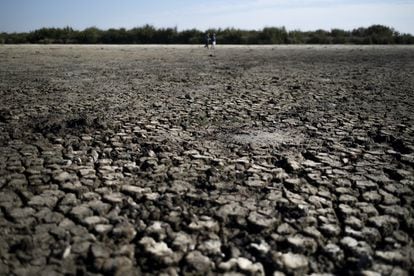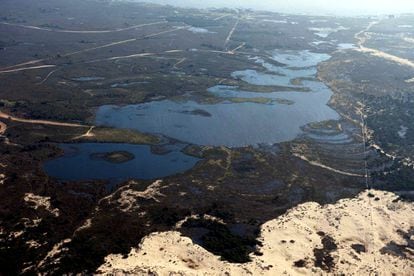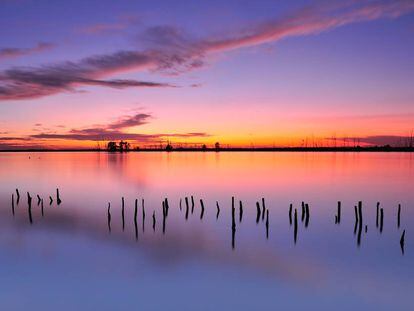Drought and illegal wells: Why Spain’s Doñana National Park is drying up
Lack of rainfall and human activity are threatening this biosphere reserve in Andalusia, which has gone from having 2,867 temporary lagoons in 2004 to just two
/cloudfront-eu-central-1.images.arcpublishing.com/prisa/K3BTMPOT2NEXHEPNQQOKU4WH5M.gif)

Biologist Carmen Díaz stands dismayed on the land once occupied by the largest lagoon in the Doñana National Park, in Spain’s southern Cádiz province in Andalusia. Having covered 45 hectares in its heyday, Santa Olalla Lagoon has shrunk to an area measuring less than 0.6 hectares. “We have a pitiful water level,” says Díaz. “And if Santa Olalla dries up, that means everything is dry. It’s devastating.”
The landscape looks bleak despite the beauty of the flamingos and ducks perched on the sandy wetland, which is also shrinking fast. If it does not rain hard soon, all the peridunal lagoons – those attached to the dunes – will disappear, something that has occurred just twice in the last 50 years: in 1983 and 1995. In the whole of October, which typically has the highest rainfall, only 10.2 mm has fallen, according to the nearby Almonte weather station in Huelva, an amount equivalent to just 2% of the annual rainfall.
The drought is affecting 4.3 million people in the Guadalquivir basin and was declared by the central government on November 2 to be having a dramatic impact on Doñana, a biosphere reserve where species of flora and fauna are struggling to survive. But the lack of rain is only half the story; according to scientists, it is merely exacerbating the fallout from the use of illegal boreholes on farms bordering the park and in the tourist coastal resort of Matalascañas, where 150,000 visitors spend their vacations less than a kilometer from the northernmost lagoons.
This massive theft of groundwater for irrigation in strawberry greenhouses and to supply unbridled human consumption, including the upkeep of a nearby golf course, has sucked dry the huge aquifer of 2,409 square kilometers. Now, the surface water in the lagoons is vanishing because much of the subsoil is dry. Proof of this is that the lagoons are shrinking even when rainfall has been at the annual average of 540 milimeters as recorded over the last 40 years – it was 454 milimeters during the 2019/2020 cycle.

“The first report denouncing the pitiful state of Doñana dates back to 1988, and nothing was done until 2019. What will be left here when they bring water? Will we still have vulnerable species?” asks Díaz, who works for the department of Wetland Ecology at the Doñana Biological Station, which is part of the Spanish National Research Council (CSIC). At the wheel of an all-terrain vehicle, Díaz navigates the paths narrowed by vegetation. She drives past one dried-up lagoon after another: El Taraje, El Zahíllo, Charco del Toro. There’s no trace of the valuable wetlands and hardly any animal life, only reeds and tamarisks that stand up to six meters and fill the lagoons.
On April 27, 2004, an airborne sensor from the National Institute of Aerospace Technology (INTA) flew over Doñana to map out its lagoons with a resolution of half a square meter and found 2,867 temporary ponds in Spain’s most iconic protected area, which is also a UNESCO World Heritage Site. At the end of October, just two of these lagoons remained: Santa Olalla and Dulce, both measuring 45 centimeters at their deepest point.

In 1988, Ramón Llamas, professor of Hydrology at Madrid’s Complutense University, denounced the Andalusia regional government and central authorities for the “conspiracy of silence” that allowed water to be pumped to the tourist development of Matalascañas, located in Almonte municipality in Huelva province, just a stone’s throw from the lagoons. Thirty-three years later, complaints about the lack of a response from the authorities persist; and hundreds of clandestine water catchments are still active on strawberry farms that amount to 1,653 hectares of illicit greenhouses, according to conservation group World Wildlife Fund. In 2019, the Hydrographic Confederation of the Guadalquivir, which works under the Ecological Transition Ministry, closed 77 of these wells and, in the last three years, its inspectors have opened 573 legal proceedings, but illegal irrigation continues.
In July 2020, after decades of protests from scientists and ecologists, the central government – which is headed by a coalition of the Socialist Party (PSOE) and junior partner Unidas Podemos – finally declared the aquifer “overexploited.” Now the Confederation is mapping out a series of measures, such as a transfer of surface water and the relocation of the two Matalascañas boreholes closest to the park that extract 2.75 cubic hectometers per year. However, the date being looked at for these measures is 2027. Meanwhile, the EU Court of Justice ruled last June that Spain was in breach of EU nature legislation because it had not addressed the illegal wells or adopted measures to avoid protected habitats being altered by the draining of the aquifer.
Laura Serrano, a researcher at Seville University’s Department of Plant Biology and Ecology, is very critical of the central and regional government. “Everything has been painful; the nature of the peridunal lagoons, which are one of the reasons Doñana was declared a biosphere reserve, has changed,” she says. “And those closest to Matalascañas are now terrestrial ecosystems. This cannot be reversed. The disaster has already happened.”
Despite the almost total loss of peridunal lagoons, the latest report on the state of the aquifer prepared by the Confederation last May states that the area’s “piezometric state is in accordance with the climatology.” Piezometers are tubes that measure the water level of the aquifer.
But Serrano disagrees. “It is a real disgrace that scientists are not listened to in this country,” she says. “We do not learn from our mistakes; we are incapable of preventing catastrophes that have been forecast and we prioritize votes and urban development. We have to learn to prevent rather than cure, because environmental restoration does not have the potential to reverse certain processes. It is a fallacy to believe that restoration will give us back what we lose. When we lose habitats and their diversity, we lose the information that some species have accumulated over hundreds of thousands of years of evolution.”
The Confederation declined to comment for this report.

While groundwater abstraction for Matalascañas equates to 2.75 cubic hectometers per year, the water pumped for irrigated land ranges between 60 and 90 cubic hectometers, as calculated by two scientific investigations in 1993 and 2011. Serrano and Díaz published an article in 2017 in the Journal of Arid Environments in which they flagged up “the lack of control and indifference” of the Confederation in the face of scientific evidence demonstrating the direct damage from the greenhouses and Matalascañas on Doñana’s water system.
Eleven of the 13 species of amphibians in southwestern Spain live in Doñana and every week Díaz is aware that the population of toads, newts and frogs is dwindling as their habitat is reduced to the two permanent lagoons and several small trenches that have been dug to ensure water in summer. “The aquifer reserve is no longer what it was,” says Díaz. “Forty-two types of dragonflies have been identified here since 1959 but this year I haven’t recorded more than 20.”
Isidoro Román, a member of the Doñana Biological Station’s monitoring team, adds: “The decrease in water is gradual, the lagoons have gone from filling less to not filling at all. In 2010, we went through the marsh on a boat, but that’s no longer the case and now evaporation is also faster due to the high temperatures.”

/cloudfront-eu-central-1.images.arcpublishing.com/prisa/IO6342HZJ5C6PDTCE36W5BP3VM.jpg)











































